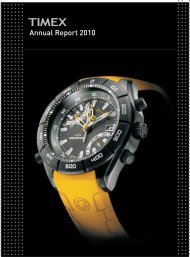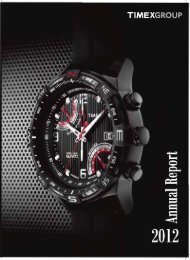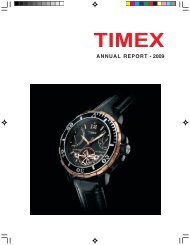Annual Report-FY 2012-13 - Timex Group India
Annual Report-FY 2012-13 - Timex Group India
Annual Report-FY 2012-13 - Timex Group India
Create successful ePaper yourself
Turn your PDF publications into a flip-book with our unique Google optimized e-Paper software.
DIRECTORS’ REPORTTo the Members of <strong>Timex</strong> <strong>Group</strong> <strong>India</strong> LimitedYour Directors are pleased to present the Twenty-fifth <strong>Annual</strong> <strong>Report</strong> and Audited Statement of Accounts for the year ended 31March 20<strong>13</strong>.FINANCIAL RESULTSRs. in Lakhs<strong>2012</strong>-<strong>13</strong> 2011-12Income 12,168 18,391Expenditure 16,364 17,786EBIDTA (3,875) 911Interest 98 109Depreciation 223 197Profit before tax (PBT) (4,196) 605Provision for Taxes - 152Profit after Tax (4,196) 453<strong>2012</strong>-<strong>13</strong> was a very difficult financial year. Revenues and profit declined 34% and 46 crores, respectively. These declines weredriven by a combination of a weaker economic climate and higher costs due to the devaluation of the Rupee. Additionally,revenues were reduced as we implemented improved credit controls and new strategies against some of our trade channels. Thesechanges were necessary to ensure a healthy long term business and we are already beginning to show positive results.The Company is committed to improving its top and bottom line financial performance through three focused and simplestrategies. In the near-term, the Company’s focus will be on the following: 1) Generate positive cash to reinvest in profitablegrowth, 2) Grow revenues by more closely aligning product offerings with consumer demand, and 3) Rationalize and realignspending to drive profitable growthAs part of its focus on cash, over the past two quarters the Company instituted more stringent Credit Management policies as wellas efforts aimed at eliminating unproductive investments in Working Capital. While the Credit Management policies temperedrevenues somewhat, they were necessary in order to balance revenues with collection of accounts receivable to generate cash.And within Operations, a more closely integrated sales forecasting and production process was implemented to ensure maximumproductivity of investments in inventory. These initiatives will be a critical enabler to provide the cash necessary to permitbusiness-critical investments in new products, advertising and store openings going forward.In terms of leadership, during fiscal <strong>2012</strong>-20<strong>13</strong>, Mr. M.K. Bandyopadhyay was appointed Acting Managing Director, replacingMr. V.D. Wadhwa who resigned on January 31, 20<strong>13</strong>.By placing greater focus on the above short-term objectives, the Company expects future financial performance to improvesubstantially. However, fiscal 20<strong>13</strong>-2014 will be a transition year. While it is expected that significant progress will be achievedin fiscal 20<strong>13</strong>-2014, it is also expected to be a year of depressed financial performance as comparatively weak economic conditionspersist and as the costs associated with the transition to a healthier business continue.MANAGEMENT DISCUSSION AND ANALYSISTHE INDIAN WATCH MARKET – Industry Structure and DevelopmentThe present size of the <strong>India</strong>n watch industry is estimated at INR 5,000 crore. The unorganized sector of watches is estimated tobe more than double the size of the organized sector in the country. The average growth in the size of the market is slated to besteady.While the unit growth is driven by low price unbranded products, the growth at the mid and higher price points is driven by creatinghigher value through improved styling and technology, which your Company is well positioned to take advantage of.The economy and mass segments form close to 80 per cent of the market by volume and contribute only 40 per cent of the market byvalue. Affordable luxury and luxury segments are estimated to contribute around 20 per cent of the market by value and have a smallvolume of around one lakh pieces. Around 60 per cent of the market by value is controlled by organized players.Currently, the major challenges faced by the industry are stringent government regulations, economic slowdown and slower thananticipated change in the consumer behavior and the large unorganized market.OUTLOOK/ OPPORTUNITIES AND CHALLENGESFactors like increasing consumerism and strong middle class present us with an opportunity within Timewear industry innear future. TGIL has an advantage of a strong brand portfolio spread across mass to premium to luxury along with domesticmanufacturing capabilities. This allows international products to be sold in <strong>India</strong> at prices which offer “Value for Money”proposition to the consumer.8





